Alien Artefacts
Most intelligent species produce interesting artefacts.
Some are more incomprehensible than others, especially those with cultural
value.
Gamenano
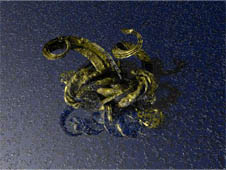 A
kind of toy or waste product of some Mother nano design. The nanites use
material from the surroundings to build something, but due to faulty programming
or deliberate design the result is random. The nano comes in spherical
plastic packages that activate when broken. The nanites begin to build,
metabolising the package, parts of the surroundings and nutrients inside
to create a structure, which could become anything. Mothers seem to enjoy
starting up gamenano to see what it makes, appreciating the chaotic beauty
of the structures that sometime develops (most of the time the result
is just inert glop). Being too close to active gamenano is not advisable.
A
kind of toy or waste product of some Mother nano design. The nanites use
material from the surroundings to build something, but due to faulty programming
or deliberate design the result is random. The nano comes in spherical
plastic packages that activate when broken. The nanites begin to build,
metabolising the package, parts of the surroundings and nutrients inside
to create a structure, which could become anything. Mothers seem to enjoy
starting up gamenano to see what it makes, appreciating the chaotic beauty
of the structures that sometime develops (most of the time the result
is just inert glop). Being too close to active gamenano is not advisable.
Nanoimmune System
 A
very useful artefact, unfortunately rare among the Mothers humanity has
contacted. It consists of nodes of nanoassemblers that are inserted into
the body, producing defensive nanodevices. After an initial training phase
where they learn to recognize everything in the body, they will attack
intruding structures. Beside an improvement of disease resistance, the
host will become immune against many nanotechnological attacks. Apparently
this is widely used in the more nanotech oriented clans.
A
very useful artefact, unfortunately rare among the Mothers humanity has
contacted. It consists of nodes of nanoassemblers that are inserted into
the body, producing defensive nanodevices. After an initial training phase
where they learn to recognize everything in the body, they will attack
intruding structures. Beside an improvement of disease resistance, the
host will become immune against many nanotechnological attacks. Apparently
this is widely used in the more nanotech oriented clans.
[Increases Con with 1,4 or 8 for purposes of disease and nanotech resistance depending on quality. ]
Starship Seed
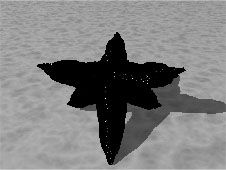 One
of the best-sellers of the Balanced Mediators: seeds for Mother starships
and bases. The seeds are small devices (a few centimetres across) that
are simply planted in a suitable asteroid. They unfold into a microfactory,
digests asteroid material and build more nanosystems, forming a fractal
mass. Eventually the whole asteroid is converted into useful material
(and some waste dust) and grows into the desired structure. During the
early phases of growth the sprouting seed can be programmed, allowing
customisation of the product. The seeds are created by the Affiliate Index,
a clan specialising in nanotechnological engineering. They also sell the
Mediators other seeds, ranging from simple tools to weapons.
One
of the best-sellers of the Balanced Mediators: seeds for Mother starships
and bases. The seeds are small devices (a few centimetres across) that
are simply planted in a suitable asteroid. They unfold into a microfactory,
digests asteroid material and build more nanosystems, forming a fractal
mass. Eventually the whole asteroid is converted into useful material
(and some waste dust) and grows into the desired structure. During the
early phases of growth the sprouting seed can be programmed, allowing
customisation of the product. The seeds are created by the Affiliate Index,
a clan specialising in nanotechnological engineering. They also sell the
Mediators other seeds, ranging from simple tools to weapons.
Li Maker
 A
soft, organic-looking lilac pyramid producing neuronano. It runs on a
concentrated sucrose solution and air, filling small cylindrical vials
with a solution containing the neuronano. It can produce ten doses per
hour, assuming it gets enough nutrients. Later models, when the Linkers
have fully allied with the Li, will produce up to ten times as much nanites.
The Maker is tamper-proof and contains a hidden nanocomputer network that
will record everything going on around it, transmitting the information
when given the correct signal. It can also produce different kinds of
nanodevices, not just Li, but this is another secret of the Linkers.
A
soft, organic-looking lilac pyramid producing neuronano. It runs on a
concentrated sucrose solution and air, filling small cylindrical vials
with a solution containing the neuronano. It can produce ten doses per
hour, assuming it gets enough nutrients. Later models, when the Linkers
have fully allied with the Li, will produce up to ten times as much nanites.
The Maker is tamper-proof and contains a hidden nanocomputer network that
will record everything going on around it, transmitting the information
when given the correct signal. It can also produce different kinds of
nanodevices, not just Li, but this is another secret of the Linkers.
Filigree Diplomat Fragment
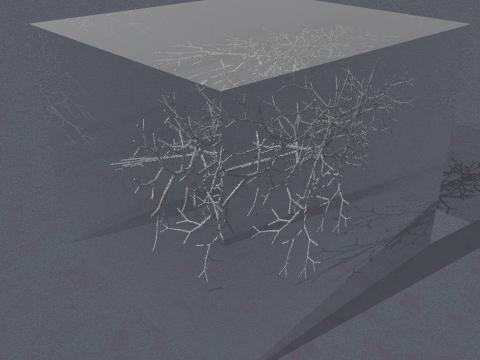 In
2289 a Filigree diplomat was carried (by its own orders) to visit the
town of Anne. The population, dominated by xenophobic fundies rioted,
and in the riot the diplomat was attacked and broken against a marble
floor. The fragments eventually ended up as souvenirs or were collected
by the New America Department of Security Xenological section (NADS-X).
Studies revealed that the diplomat consisted of a complex silicon-diamond
circuitry, apparently including nanotechnological processing nodes; very
impressive, but of little use in learning about the Filigrees. Several
pieces (as well as forgeries) still exist in private collections.
In
2289 a Filigree diplomat was carried (by its own orders) to visit the
town of Anne. The population, dominated by xenophobic fundies rioted,
and in the riot the diplomat was attacked and broken against a marble
floor. The fragments eventually ended up as souvenirs or were collected
by the New America Department of Security Xenological section (NADS-X).
Studies revealed that the diplomat consisted of a complex silicon-diamond
circuitry, apparently including nanotechnological processing nodes; very
impressive, but of little use in learning about the Filigrees. Several
pieces (as well as forgeries) still exist in private collections.
The Teachings of Hahss-Trasn
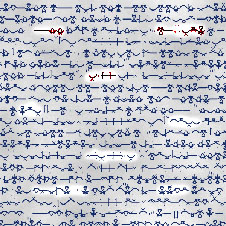 The
Trahans dislike destroying information, even highly dangerous information.
Instead the Harmony police or other groups such as the Safety Librarians
track down and hide dangerous books, files or evidence that threatens
Trahan social stability. The Teachings of Hahss-Trasn belong in this category
of "un-books" that are hidden in the secret libraries of the Empire.
The
Trahans dislike destroying information, even highly dangerous information.
Instead the Harmony police or other groups such as the Safety Librarians
track down and hide dangerous books, files or evidence that threatens
Trahan social stability. The Teachings of Hahss-Trasn belong in this category
of "un-books" that are hidden in the secret libraries of the Empire.
The Teachings of Hahss-Trasn are a philosophical weapon, the seed that brought down the Outer Imperial Pair in the 80th dynasty and ushered in the Third Period of Anarchy. The Teachings delineate a philosophical system that seems highly reasonable and unites both the tenets of passion cultism with Empire Worship; many Trahans would find such a neat combination nearly irresistible. But the system is deliberately flawed, which is only apparent after careful study by an expert or if it is implemented politically. It was actually designed by a group of dissident academics to bring down the hated government and give them the chance to seize power. The Teachings would likely be virulent and dangerous today too, if discovered and spread.
Nahl Strap-Knife
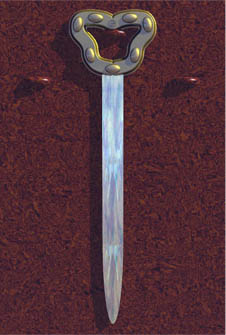 An
ancient Trahan weapon, developed during the Second Period of Anarchy as
an assassination tool. Today they are still in use among some parts of
the underworld, sometimes as a badge of honour. It is a disposable one-use
weapon made of smart plastic. The knife consists of a matrix of coloured
(usually iridescent) plastic, reinforced with polymer fibres. It is flexible
and behaves not unlike a typical strap for Trahan clothing. At one end
there is a metal fastener. By activating the fastener with a secret button
the fibres suddenly stiffen, making the strap straighten out and become
a quite deadly weapon. It is used for stabbing (the matrix peels away,
leaving the sharp and often poisoned fibres to penetrate the victim) or
for disabling an opponent by "strangling" their neck and using the device
as a self-tightening cutting garrotte. Some versions have a third use:
by twisting the collar the fibres will splay, which provides a coup de
grace if the knife has been successful in impaling the victim, or a defensive
hemisphere of sharp needles if the would-be assassin needs to get away.
An
ancient Trahan weapon, developed during the Second Period of Anarchy as
an assassination tool. Today they are still in use among some parts of
the underworld, sometimes as a badge of honour. It is a disposable one-use
weapon made of smart plastic. The knife consists of a matrix of coloured
(usually iridescent) plastic, reinforced with polymer fibres. It is flexible
and behaves not unlike a typical strap for Trahan clothing. At one end
there is a metal fastener. By activating the fastener with a secret button
the fibres suddenly stiffen, making the strap straighten out and become
a quite deadly weapon. It is used for stabbing (the matrix peels away,
leaving the sharp and often poisoned fibres to penetrate the victim) or
for disabling an opponent by "strangling" their neck and using the device
as a self-tightening cutting garrotte. Some versions have a third use:
by twisting the collar the fibres will splay, which provides a coup de
grace if the knife has been successful in impaling the victim, or a defensive
hemisphere of sharp needles if the would-be assassin needs to get away.
[Skill: Melee-blade Acc: 0 Range: personal Type: Li/O Damage: d4w/d4w+1/d4+2w + poison. Actions: 4 Hide: -2 Mass: 100g Can only be used for one attack plus a splaying attempt (does damage as another attack)]
Trahan Gauss Gun
An ancient and rare weapon based on accelerating bullets with a strong electromagnetic pulse just like a rail gun. It consists of battery and ammo packs worn on the body (often combined with armor) connected to the gun itself, which consists of a light, open framework of plastics and superconductors. The gun itself is held by a number of straps to the forearm, with the fingers resting in depressions on the top surface. It is possible to smoothly adjust firing rate (from single shot to automatic), zoom on the telescope and velocity of the bullets (from merely attention-getting to deadly) by manipulating sliders in the depressions.
To improve aiming, the gun is fitted with an integral telescopic sight connected through an optical fibre bundle to an eyepiece. Using clever active optics, it acts both as a light amplifier, adjustable telescope and translates the light into a red overlay. The bullets are self-shaping: as they are propelled out of the gun they adapt to aerodynamic drag and become dart-shaped. Recoil is minimised using a system of gyros.
It is possible for a Trahan to use two guns, although it likely requires much training or being ambidextrous. There are stories about venerable gunslingers using four, one in each hand, but they all date back centuries.
The designs are adapted to Trahan hands and bodies, making them very
hard (+3) to use by humans.
[ Skill: Mod pistol. Acc: -2 Md: F/B/A Range:20/40/80 Type: Hi/O-G Damage: d6w/d6+2w/d6m (or lower) Actions: 8 Clip size: 144 Hide: +2 Mass: 1/5 (gun/batteries) Not available outside Trahan intelligence agencies or advanced police forces. ]
The Ten Areas
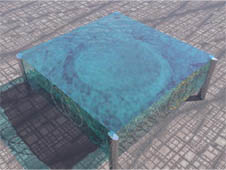 Ten
locations on Traha are regarded as having especial Tress - "sacredness/historical
relevance". Reproductions of these locations, ranging from the Garden
of the Online Emperor to the undersea craters of Hee-Ssrarr, have become
traditional gifts. Modelbuilders and mini-gardener try to create exact
replicas, and having a perfectly maintained Area is regarded as a status
symbol. The Imperial Couple are regarded as having the perfect versions,
the Areas themselves.
Ten
locations on Traha are regarded as having especial Tress - "sacredness/historical
relevance". Reproductions of these locations, ranging from the Garden
of the Online Emperor to the undersea craters of Hee-Ssrarr, have become
traditional gifts. Modelbuilders and mini-gardener try to create exact
replicas, and having a perfectly maintained Area is regarded as a status
symbol. The Imperial Couple are regarded as having the perfect versions,
the Areas themselves.
Ur-Mother Cylinder
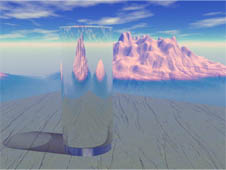 These
artefacts have been recovered from a few Ur-Mother sites. The devices
look like crystal cylinders, 11.34 centimetres in diameter and 42.19 centimetres
long, with strange diffraction patterns playing through their interiors.
They are made of diamond, with information inscribed in the 3D matrix
using carbon 12 and carbon 13 atoms. The information density is extremely
high (approximately 1.5*1021 bits per cubic centimetre; a cylinder
could hold 6.4*1026 bits, more than all human and Mother libraries
together). Unfortunately none have ever been decoded, since the information
appears to be largely compressed and possibly encrypted. Many mothers
keep them as expensive "questioning pieces".
These
artefacts have been recovered from a few Ur-Mother sites. The devices
look like crystal cylinders, 11.34 centimetres in diameter and 42.19 centimetres
long, with strange diffraction patterns playing through their interiors.
They are made of diamond, with information inscribed in the 3D matrix
using carbon 12 and carbon 13 atoms. The information density is extremely
high (approximately 1.5*1021 bits per cubic centimetre; a cylinder
could hold 6.4*1026 bits, more than all human and Mother libraries
together). Unfortunately none have ever been decoded, since the information
appears to be largely compressed and possibly encrypted. Many mothers
keep them as expensive "questioning pieces".
The Fundamental State Data
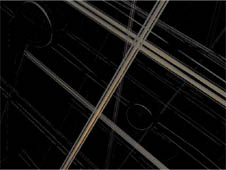 Immense
databases given to the Mothers by the Ur-Mothers. They contain lists of
consistent and semiconsistent mathematical systems; interesting to metamathematicians
but not very relevant to anybody else. Mother anthropologists have tried
to figure out the uses for the State Data and what it tells about the
Ur-Mothers, but with few clear results. Together with the Cylinders they
only make the Ur-Mothers more enigmatic.
Immense
databases given to the Mothers by the Ur-Mothers. They contain lists of
consistent and semiconsistent mathematical systems; interesting to metamathematicians
but not very relevant to anybody else. Mother anthropologists have tried
to figure out the uses for the State Data and what it tells about the
Ur-Mothers, but with few clear results. Together with the Cylinders they
only make the Ur-Mothers more enigmatic.
The Trap
 A
dangerous artefact left by the Ur-Mothers. It consists of a network of
nanodevices controlled by tiny nodes the size of dust grains, distributed
across the surfaces of lifeless planets or the middle-phase megastructures.
If they are disturbed by anything they recognise as alien to their environment,
they begin to analyse and attack. Their original purpose was to protect
installations from attacks on the nanoscale and upwards, a kind of planetary
or system-wide immune system. But now it lacks central control and just
attacks anything alien, the installations the system was to protect are
long gone.
A
dangerous artefact left by the Ur-Mothers. It consists of a network of
nanodevices controlled by tiny nodes the size of dust grains, distributed
across the surfaces of lifeless planets or the middle-phase megastructures.
If they are disturbed by anything they recognise as alien to their environment,
they begin to analyse and attack. Their original purpose was to protect
installations from attacks on the nanoscale and upwards, a kind of planetary
or system-wide immune system. But now it lacks central control and just
attacks anything alien, the installations the system was to protect are
long gone.
At first nanodevices try to sample whatever alien stuff is around, and the nodes begin to build disassemblers that pick it apart. Spacesuits will start to exhibit corrosion, equipment will begin to fail, easily dissolved surfaces will melt. If this doesn't work, the nodes will grow, becoming tiny flecks of black lichen here and there, producing new nanites finding weaknesses to exploit. As time goes on, the nodes replicate more and more, building larger and more powerful weapons such as laser-equipped ant-like devices, bombs or liquid masses of disassembler goo.
Solarian Network Node
 Nobody
in the colonies knows how the solarian computer networks work, but evidence
suggests that they are able to communicate practically instantaneous across
vast distances without sending any detectable signal (a similar ability
is believed to be used by the filigrees); the most common theory is that
microscopic wormholes are used to transmit data. The network nodes (which
can be of any size) are embedded in equipment, solarian bodies and their
constructions. The two expeditions to Sol have come back with some samples,
but so far none have been made to work and the internal workings remain
a mystery. Should somebody figure out how to use them, then the benefits
of FTL communications would become available (at least between the nodes
possessed by the colonies) and possibly even access to the Sol data net.
Nobody
in the colonies knows how the solarian computer networks work, but evidence
suggests that they are able to communicate practically instantaneous across
vast distances without sending any detectable signal (a similar ability
is believed to be used by the filigrees); the most common theory is that
microscopic wormholes are used to transmit data. The network nodes (which
can be of any size) are embedded in equipment, solarian bodies and their
constructions. The two expeditions to Sol have come back with some samples,
but so far none have been made to work and the internal workings remain
a mystery. Should somebody figure out how to use them, then the benefits
of FTL communications would become available (at least between the nodes
possessed by the colonies) and possibly even access to the Sol data net.